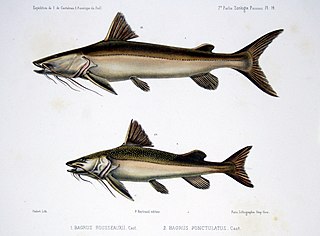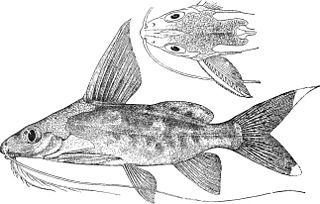The suckermouthed catfish is a tropical fish belonging to the armored suckermouth catfish family (Loricariidae). Hypostomus punctatus is a freshwater fish native to South America, in the coastal drainages of southeastern Brazil and Uruguay. It is one of a number of species commonly referred to as 'plecostomus' or 'common pleco' by aquarists.

The walking catfish is a species of freshwater airbreathing catfish native to Southeast Asia. It is named for its ability to "walk" and wiggle across dry land, to find food or suitable environments. While it does not truly walk as most bipeds or quadrupeds do, it has the ability to use its pectoral fins to keep it upright as it makes a wiggling motion with snakelike movements. This fish normally lives in slow-moving and often stagnant waters in ponds, swamps, streams and rivers, flooded rice paddies or temporary pools which may dry up. When this happens, its "walking" skill allows the fish to move to other sources of water. Considerable taxonomic confusion surrounds this species and it has frequently been confused with other close relatives.

Pseudoplatystoma is a genus of several South American catfish species of family Pimelodidae. The species are known by a number of different common names. They typically inhabit major rivers where they prefer the main channels and tend to stay at maximum depth, but some species can also be seen in lakes, flooded forests, and other freshwater habitats. They have robust bodies, and are important food fish.

The redtail catfish, Phractocephalus hemioliopterus, is a pimelodid (long-whiskered) catfish. In Venezuela it is known as cajaro and in Brazil it is known as pirarara. It is the only extant species of the genus Phractocephalus. This fish is common in the aquarium trade, although its massive adult size makes it unsuitable for all but the largest aquariums.

The Ariidae or ariid catfish are a family of catfish that mainly live in marine waters with many freshwater and brackish water species. They are found worldwide in tropical to warm temperate zones. The family includes about 143 species.

Pterygoplichthys or commonly known as Janitor fish is a genus of South American armored catfishes. These fish are commonly known as sailfin armoured catfish or sailfin plecs.

Acanthicus is a genus of large, South American suckermouth armored catfishes native to the Amazon and Orinoco basins, and possibly in Guyana. The name Acanthicus is derived from the Greek, akanthikos meaning thorny, spiny. Fish of this genus are known as lyre-tail plecos. These species are found in large rivers, primarily in areas with a rocky bottom and a moderate or strong current.

Hypancistrus is a genus of loricariid catfish originating from the Amazon basin in South America. Unlike many of the other Loricariids, however, some Hypancistrus species are more carnivorous and enjoy meat in their diet. Hypancistrus species are popular aquarium fish, including such popular fish as the zebra pleco and Queen Arabesque pleco.

Brachyplatystoma is a genus of catfish from the family Pimelodidae. As the occasionally used common name goliath catfishes indicates, this genus includes some of the largest species of catfish, including the piraíba, B. filamentosum, which reaches up to the region of 3.6 metres (12 ft) in length. Brachyplatystoma are found in the Amazon and Orinoco basins, and other tropical freshwater and brackish habitats in South America. Some species are migratory. These fish are important as food fish and, to some extent, aquarium fish.

Hemibagrus wyckioides is a species of catfish of the family Bagridae.
Hemibagrus wyckii is a species of catfish of the family Bagridae. It is occasionally called the crystal-eyed catfish.
Raphael catfish may refer to a number of different South American doradid catfish species:

Acanthodoras is a genus of thorny catfishes native to rivers of tropical South America.

Leiarius is a genus of long-whiskered catfishes native to South America. Most of the genus' species are found in the aquarium hobby as ornamental fish.

Leporacanthicus is a genus of suckermouth armored catfishes native to South America.

Bunocephalus is a genus of banjo catfishes from South America. It is found in Magdalena, Orinoco, Amazon, Paraguay-Paraná, and São Francisco Rivers. It is also the only aspredinid genus found west of the Andes, found in the Atrato, San Juan, and Patía Rivers. This genus is a part of the family Aspredinidae, known as banjo catfishes for their large, flattened heads and slender tails that give the appearance of a banjo. Most species exhibit cryptic coloration, and the same holds true among Bunocephalus species. The skin is completely keratinized and is covered by large, unculiferous tubercles. Bunocephalus species may reach up to 13 centimetres SL.

Synodontis alberti, the bigeye squeaker, Albert's syno, bigspotted squeaker, or high-fin synodontis, is a species of upside-down catfish native to the Congo Basin of Cameroon, the Democratic Republic of the Congo and the Republic of the Congo. It was originally described in 1891 by Belgian ichthyologist Louise Schilthuis after its discovery in the Malebo Pool of the Congo River.

Neoarius berneyi, the highfin catfish, Berney's catfish, Berney's shark catfish, or the lesser salmon catfish, is a freshwater sea catfish that is commonly kept in aquariums. The origin of the name Neoarius berneyi is Greek, with the genus name Neoarius coming from the words neos meaning new and arios, meaning warlike or hostile, in reference to the well developed fin spines, and the species name, berneyi, comes from the ornithologist F. L. Berney.


















